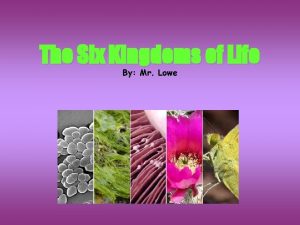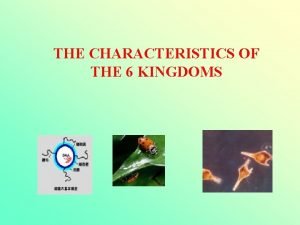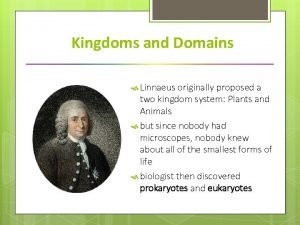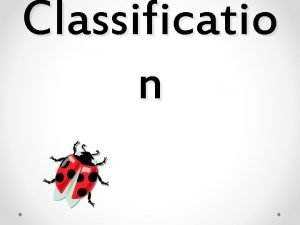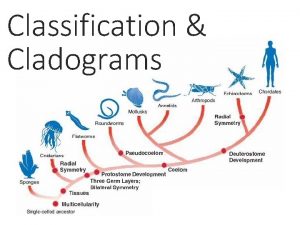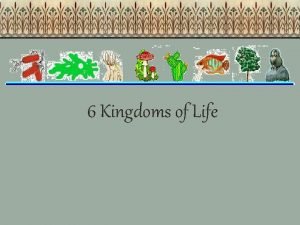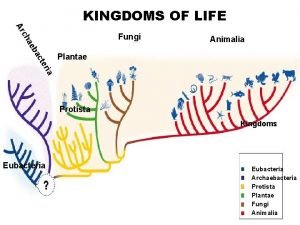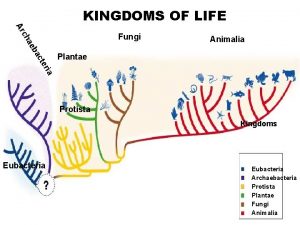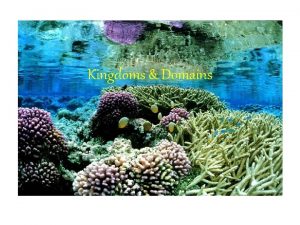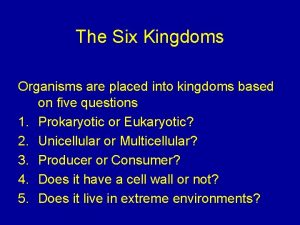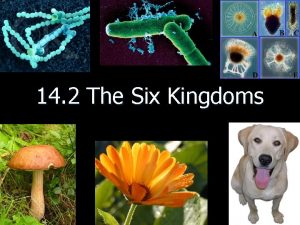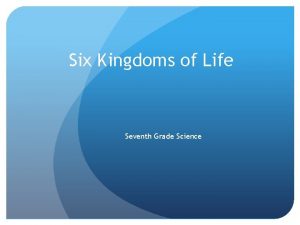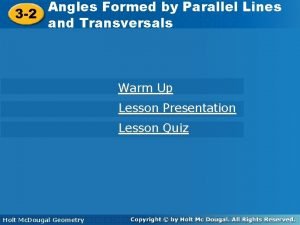The Six Kingdoms How Are Kingdoms Formed Scientists

















- Slides: 17

The Six Kingdoms!

How Are Kingdoms Formed? Scientists classify organisms into 6 different kingdoms based on: 1) The presence of a nucleus Eukaryotic/Prokaryotic 2) The number of cells Unicellular/Multicellular 3) The ability to move 4) The method of obtaining food

Old 5 Kingdom system Monera Protists Plants Fungi Animals New 3 Domain system Bacteria Archaebacteria Eukaryotes Protists Plants Fungi Animals Archaebacteria Eubacteria

Kingdom Bacteria Kingdom Archaebacteria Kingdom Protista Kingdom Fungi Kingdom Plantae Kingdom Animalia

Kingdom Type of Cell Wall # of Cells Cell Type: Prokaryotic Cell Wall? Present # of Cells: Unicellular Obtain Food Movement Environment Reproduction Movement: Some are able(flagella) Environment: Feeding: Extremes! Sunlight, Gasses or Ions Ex: High salt, temp Obtain it from animals/plants Reproduction: Asexual

Archaebacteria Prokaryotic Possess a Cell Wall Unicellular Obtain Energy: WIDE RANGE!! Organic Compounds (sugars) Sunlight Ammonia/Metal Ions/Hydrogen Gas Movement: Flagella Environment: EXTREMOPHILES! Halophiles Acidophiles Theromophiles Alkaliphiles Even Mars? ? Reproduction: Asexual – Binary Fission

Kingdom Type of Cell Wall # of Cells Obtain Food Cell Type: Prokaryotic Cell Wall? Present # of Cells: Unicellular Feeding: Photosynthesis, Chemicals Decompose dead material Movement Environment Reproduction Movement: Some are able Flagella, tumbling Environment: Common places – us! Reproduction: Asexual

Eubacteria Prokaryotic Possess Cell Walls Unicellular Obtain food: Photosynthesis Use Chemicals (nitrogen, hydrogen, sulfur) Decompose plants/animals Movement: Flagella Tumbling Re-arranging cytoskeleton Environment: Within every habitat on Earth Even in you! (There are 10 x the number of bacteria cells in you body than human cells) Reproduction: Asexual – Binary Fission

Begin to think about your poem…. . Example: And now my friends…. if I ran the zoo. I’d organize the other bacteria in the kingdom of “Eu” These unicellular creatures would be happy as clams. Living in a great many habitats and lands. In the sea, in the air, in my yogurt and shoe, My prokaryote friends would multiply in two! Oh yes, the great process of binary fission – Don’t you remember cellular division? They’d decompose the dead, and produce their own food. Can’t you see it now Zoologist dude?

Kingdom Protista Type of Cell Wall Eukaryoti Yes c Cell Type: Eukaryotic Cell Wall? Present in some # of Cells: Uni/Multi Cellular # of Cells Obtain Food Movement Environment Multi. Most can move Virtually Consumer cellular everywhere!! *Require oxygen *Must obtain homeostasis Movement: Some are able Flagella, cillia, pseduopods Environment: Must live in water! Feeding: Photosynthesis Organic Compounds (plants/animals) Reproduction: Asexual/Sexual Reproduction Sexually or Asexually

Protista Eukaryotic : There are 60, 00 different types Some Possess Cell Walls Unicellular or Multicellular (but they do not have specialized tissues) Obtain food: Photosynthesis Organic Compounds (Plants/Animals) Movement: Flagella Cillia Pseudopods – False foot Non-Mobile Environment: Must live in liquid (water) Reproduction: Sexual or Asexual

Kingdom Type of Cell Wall # of Cells Obtain Food Cell Type: Eukaryotic Cell Wall? Present # of Cells: Multi Cellular Feeding: Photosynthesis (producers) Movement Environment Reproduction Movement: Non-mobile (by itself) Parts Can Move Environment: Virtually everywhere! Reproduction: Asexual/Sexual

Plantae Eukaryotic – 287, 655 species! Possess Cell Walls Multicellular Obtain food: Photosynthesis Require: Oxygen, Carbon Dioxide, Water, Essential Nutrients (from soil) Movement: Most of plant = non-mobile Plants will grow toward light, leaves move Environment: Plants are found virtually everywhere Except: Arid deserts, arctic, deep ocean Reproduction: Sexual /Asexual Fun Fact! Carvings in tree stems will not move!

k c i u k Q ec h C Kingdom Type of Cell Wall # of Cells Obtain Food Cell Type: Eukaryotic Cell Wall? Present # of Cells: Multi Cellular Movement Environment Reproduction Movement: Non-mobile (by itself) Can move as a team Environment: Found in most ecosystems Feeding: Organic Compounds (plants/animals) Reproduction: Asexual/Sexual

Fungi Eukaryotic Possess Cell Walls Multicellular Obtain food: Organic Compounds (Plants/Animals) Movement: Non-mobile BUT cells can move as a team ~Through hyphae “Grow to get food” Environment: Found in most ecosystems Play major roles as decomposers Reproduction: Sexual or Asexual (spores) Fun Facts! The largest fungus is 2, 200 acres big! It takes 50 -100 years for fungi to decompose a tree

k c i u k c Q e h C Kingdom Type of Cell Wall # of Cells Obtain Food Cell Type: Eukaryotic Cell Wall? Absent # of Cells: Multi Cellular Feeding: Consume it! Movement Environment Reproduction Movement: Most can move Environment: Virtually everywhere! Require oxygen Must maintain homeostasis Reproduction: Asexual/Sexual

Animalia Eukaryotic No Cell Walls Multicellular Obtain food: Consume it! Movement: Most are mobile Environment: Found within most habitats Require oxygen Maintain homeostasis Reproduction: Sexual or Asexual Fun Fact! Ancient Greek dentists used the venom in a sting ray as an anesthetic!
 Mikael ferm
Mikael ferm What are the six kingdoms of life?
What are the six kingdoms of life? The six kingdoms
The six kingdoms 6 kingdom classification
6 kingdom classification Characteristics of each kingdom
Characteristics of each kingdom Six kingdoms worksheet
Six kingdoms worksheet What are the three domains and six kingdoms?
What are the three domains and six kingdoms? Common characteristics of the six kingdoms of life
Common characteristics of the six kingdoms of life 8 classification levels
8 classification levels Phylogenetic tree of 6 kingdoms
Phylogenetic tree of 6 kingdoms 6 kingdoms dichotomous key
6 kingdoms dichotomous key Characteristics of the six kingdoms
Characteristics of the six kingdoms What are the kingdoms of living things
What are the kingdoms of living things Classify each polygon
Classify each polygon Vẽ hình chiếu đứng bằng cạnh của vật thể
Vẽ hình chiếu đứng bằng cạnh của vật thể độ dài liên kết
độ dài liên kết Quá trình desamine hóa có thể tạo ra
Quá trình desamine hóa có thể tạo ra Môn thể thao bắt đầu bằng chữ f
Môn thể thao bắt đầu bằng chữ f

